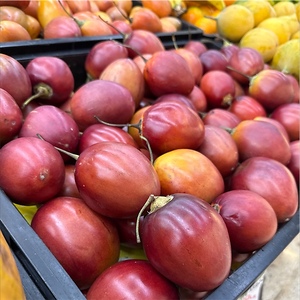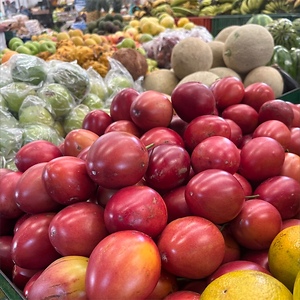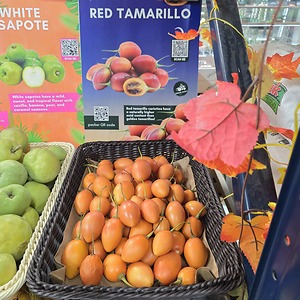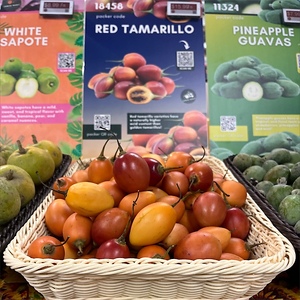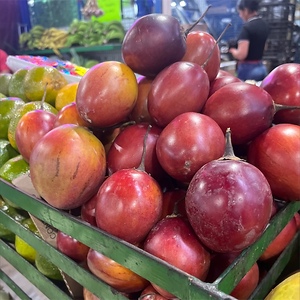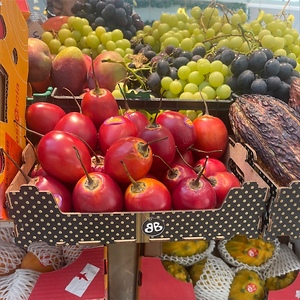


Red Tamarillos
Estimated Inventory, 30 ct : 0
Description/Taste
Red tamarillos are small, oval to egg-shaped fruits with pointed ends, averaging 4 to 6 centimeters in diameter and 6 to 8 centimeters in length. The skin is smooth, glossy, taut, and thin, ripening from orange-gold to a muted, red-brown when mature. Depending on the variety, the skin may also bear hues of purple and crimson. Underneath the surface, the flesh is semi-firm, orange, and succulent with an aqueous consistency. There are also two chambers filled with soft pulp encasing many thin, circular, and edible black seeds. Red tamarillo flesh, when ripe, has a bright, sweet-tart flavor with tangy, acidic notes. It is important to note that the skin frequently contains a bitter, tannin forward flavor and is often discarded before eating, considered to be unpalatable.
Seasons/Availability
Red tamarillos are available year-round, with a peak season in the fall through winter.
Current Facts
Red tamarillos, botanically classified as Solanum betaceum, are the small, clustering fruits of a subtropical, herbaceous shrub belonging to the Solanaceae or nightshade family. There are multiple varieties of tamarillos broadly categorized into two groups, yellow or red, with Red tamarillos being the most common color found in commercial markets. Red tamarillos are also known as Tree tomatoes, Sachatomate, and Andean tomatoes, and the word tamarillo was created in New Zealand as a part of a marketing campaign in 1967 to distinguish the fruits from the common tomato. Tamarillo was developed from the Maori word “tama,” which means leadership and the Spanish word for yellow “amarillo.” Red tamarillos are favored for their sweet and acidic flavor and are primarily used in soups and stews.
Nutritional Value
Red tamarillos are an excellent source of vitamin C, which is an antioxidant that strengthens the immune system, improves skin composition, and reduces inflammation. The fruits are also a good source of vitamin E and beta-carotene, an antioxidant that gives the flesh its orange hue and is converted into vitamin A within the body, improving eye and skin health. Beyond vitamins, Red tamarillos provide minerals such as potassium to help regulate fluid levels and contain some phosphorus, copper, magnesium, and iron. In South America, the fruits are seen as a digestive cleanser and an immune strengthener during the cold and flu season.
Applications
Red tamarillos are best suited for both raw and cooked applications, but the fruits are primarily consumed fresh to showcase their sweet and tangy flavor. It is important to note that the skin is not consumed due to its bitter flavor. To remove, the fruits can be blanched and the skin peeled, or they can be sliced in half and the flesh scooped from the skin. Red tamarillos can be sliced and tossed into salads, blended into gazpacho, or coated in sugar and consumed as a snack. The fruits can also be used as a topping over ice cream, cakes, and other baked goods, blended into smoothies and fruit juices, or slathered onto toast. When utilized in cooked applications, Red tamarillos can be grilled and served as a side dish, toasted into a grilled cheese, tossed into soups and stews, or simmered into sauces, jams, and chutney. Red Tamarillos pair well with cheeses such as brie, feta, and cheddar, arugula, avocado, pears, bell pepper, tomatoes, cucumbers, balsamic vinegar, honey, and nuts such as pine, almonds, and walnuts. The fruits can be stored at room temperature until ripe or kept up to ten days in the refrigerator.
Ethnic/Cultural Info
In Colombia, Mono Nunez is an annual music festival held in Ginebra, a region located in the Valle del Cauca. The four-day event was first held in 1974 as a part of a cultural week created by a school and is named after Benigno Nunez Moya, a resident and famous musician of Ginebra. During the festival, there are musical performances of both modern and traditional songs, including chants featuring string and wind instruments, and there are also various singing competitions held throughout the event. Mono Nunez is considered to be one of the most important Andean musical celebrations held within Colombia. In addition to the music, Ginebra is known for its gastronomy. The festival celebrates this title with many food and drink vendors, featuring innovative culinary dishes. Red tamarillos are often featured in stews and soups sold at the event.
Geography/History
Tamarillos are believed to be native to regions of the Andes Mountains, spanning across Colombia, Ecuador, Chile, Argentina, Bolivia, and Peru. Wild populations of the fruit are almost non-existent in the modern-day, primarily found in Argentina and Bolivia, but in the 19th century, the seeds were globally introduced for cultivation. New Zealand was the first country to produce tamarillos commercially, and through extensive breeding programs, new varieties of tamarillos were created, including many of the red cultivars sold in current markets. Red tamarillos were later introduced to the United States in the early 20th century, and today the fruits are found through local markets and specialty grocers in Asia, Australia, New Zealand, Africa, Europe, South America, and North America.
Recipe Ideas
Recipes that include Red Tamarillos. One







